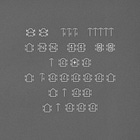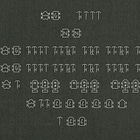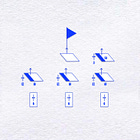Recently, while postponing the pain of writing and the travails of translation, I discovered, on the website of the German Federal Archives (Bundesarchiv), four infographics, each of which depicted the vehicles rated by one of the companies of a motorcycle infantry battalion (Kradschützen Bataillon) of a type authorized (or proposed) in 1942.
However, the folder in which I found these diagrams lacked any sort of key, legend, or explanatory text. Moreover, while some of the glyphs used to depict these vehicles matched icons depicted on the website of the legendary Leo Niehörster, others could not be found on the page provided by the o.g. of graphical orbattery.
In the hope of finding a Rosetta Stone, I used the digital equivalent of scanning the shelf that held the ink-and-paper originals of the infographics. That is, I typed slightly altered versions of the call number of the folder (RH 2/1167) into the search engine provided by the Bundesarchiv. Alas, there was no joy in Quantico that day, for the mighty Casey of Quellenkenntnis struck out.1
With that in mind, I put on my detective hat and sat down to decode the diagrams. In particular, I compared the graphics I found in the archive to those made by Christoph Widmann-Awender (of the splendid website World War II Day-by-Day.)2
I will, in the next four installments of this five-part series, describe the discoveries that resulted from the use of this technique. As you might expect, each of these posts will focus on a particular diagram, and thus a specific type of company.)
For the other posts in this series …
For more about tactical symbols …
For more about The Tactical Notebook …
This mangled metaphor recalls the proudest day of my life as a student of German military history, the day when I read, in a letter from Franz Uhle-Wettler, the words ‘I admire your Quellenkenntnis’. (I translated the latter as ‘knowledge of sources)’.
World War II Day-by-Day does not provide URLs for particular pages. Thus, to find the diagram I used, navigate to the page called Kriegsstärkenachweisungen (‘war establishments’) and, once there, look in the index marked Schnelle Truppen (‘quick troops’) for words that include the element Kraftradschützen (‘motorcycle infantry’).









It would be good to have Uhle-Wettler around to discuss incorporating drones and anti-drone measures into his scheme for decentralized infantry teams with ATGMs to blunt and break up Russian (Soviet) attacks. Is his work obsolete, or capable of updating?